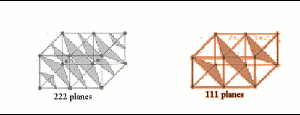[I'm talking with respect to cubic lattices alone.]
For instance, if a plane has $x,y,z$ intercepts $a/2,a/2,a/2$ (where $a$ is the lattice constant) the miller index would be $[2\space2\space2]$. The book I'm referring to says that for fractional intercepts, the indices do not have to be reduced to the smallest whole numbers(hence $[2\space2\space2]$).
But, miller indices are supposed to represent a set of parallel planes and I can't think of any other plane with the index $[2\space2\space2]$ Then I saw this:
The image(3rd row, 3rd image) shows the set of $[2\space2\space2]$ planes. I'm guessing that one of them has intercepts $a/2,a/2,a/2$. What are the intercepts of the other planes, and how are they all $[2\space2\space2]$?
Or, if my method of calculation is wrong, how else do I calculate miller indices for fractional intercepts?
PS: I've only just started to learn this concept, so it's possible that my understanding of miller indices is fundamentally flawed.


